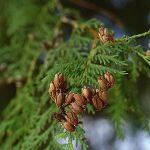| Common Name: |
Chinese Arbor-Vitae |
| Botanical Name: |
Thuja orientalis syn. Biota orientalis, Platycladus orientalis |
| Genus: |
Thuja |
| Family: |
Cupressaceae |
| Native Location: |
China and Iran |
| Cultivation: |
Deep, moist, well-drained soil in sun. Dislikes cold, drying winds when young. Trim hedges in spring and late summer. Trees may be damaged by scale insects, aphids, canker, and Keithia disease. |
| Propagation: |
By seed sown in late winter (species only); by semi-ripe cuttings in late summer. |
| Harvest: |
Foliage and bark are removed as required and dried for use in decoctions, liquid extracts, and tinctures. Seeds (T. orientalis) are collected from ripe cones in autumn and dried for use in decoctions, powders, and tinctures. |
| Variants: |
Aurea Nana
Is dwarf, with yellow-green foliage that bronzes in winter.
Height: 60cm (24in)
Width: 60cm (24in) |
|
| Height: |
15m (50ft) |
| Width: |
6m (20ft) |
| Hardiness: |
Z5-9 |
| Parts Used: |
Foliage (ce bai ye), seeds (bai zi ren) |
| Properties: |
A bitter, astringent, cooling herb that controls bleeding and coughing, stimulates the uterus, encourages hair growth, and is expectorant and anti-bacterial (foliage); a sweet, sedative, mildly laxative herb (seeds). |
| Medicinal Uses: |
Internally for coughs, asthma, hemorrhage, excessive menstruation, bronchitis, skin infections, mumps, bacterial dysentery, arthritic pain, or premature baldness (foliage); and for palpitations, insomnia, nervous disorders, and constipation in the elderly (seeds). |
| Warning: |
Preparations of leaves are contraindicated during pregnancy.
Leaves are toxic if eaten.
Skin allergen. |
| Bibliography: |
The Encyclopedia of Herbs by Deni Bown Copyright © 1995, 2001 Dorling Kindersley Limited. Pp. 386-387.
|
